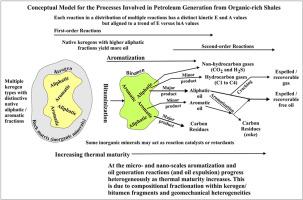Improved approach for modelling reaction kinetics for organic-rich shales, particularly oil shales
IF 4.6
0 ENERGY & FUELS
引用次数: 0
Abstract
Two methods are compared to calculate credible reaction kinetic distributions that fit S2 pyrogram curves generated by multi-heating rate pyrolysis analysis of oil shales. The fixed-A method constrains all reactions in the distribution to conform to a single frequency factor. The variable E-A (Var E-A) method allows the activation energy (E) and A to vary independently for each reaction. The reaction kinetics are important as they determine the temperature ranges at specific heating rates at which oil and gas products are generated. This study evaluates the two kinetic fitting methods using published pyrogram details from three samples of kerogen extracts from oil shale (China, Jordan, U.S.A) and one whole rock oil shale sample (China). The component reactions of the Var E-A solutions conform to the lower end of an empirically observed E-lnA trend defined by a large number of organic-rich shale formations; the fixed-A solutions do not. The temperature ranges of some Var E-A solution reactions are broader than those of the fixed-A solution, meaning that fewer reactions are required to provide effective pyrogram fits. The Var E-A solutions provide more credible explanations of the aromatization processes governed by first- and second-order reactions. involved in forming bitumen, oil/gas products and carbon residues during the thermal maturation of kerogen. A conceptual model is proposed to explain this. The differences between the fixed-A and Var E-A kinetic solutions have important implications for the design of in-situ conversion processes (ICP) for generating oil and gas products from oil shales.

富有机质页岩,特别是油页岩反应动力学建模的改进方法
对比两种方法,计算出符合油页岩多升温速率热解S2热图曲线的可信反应动力学分布。固定a法约束分布中的所有反应服从一个单一的频率因子。可变E-A (Var E-A)法允许每个反应的活化能(E)和A独立变化。反应动力学很重要,因为它决定了在特定加热速率下产生油气产品的温度范围。本文利用已发表的三个油页岩干酪根提取物样品(中国、约旦、美国)和一个完整的油页岩样品(中国)的热解图细节,对两种动力学拟合方法进行了评价。Var E-A溶液的组分反应符合由大量富有机质页岩地层定义的经验观察到的E-lnA趋势的下端;固定a的解决方案则不然。一些Var E-A溶液反应的温度范围比固定a溶液反应的温度范围更宽,这意味着需要更少的反应来提供有效的热图拟合。Var E-A解决方案为一阶和二阶反应控制的芳构化过程提供了更可信的解释。参与干酪根热成熟过程中沥青、油气产品和碳渣的形成。提出了一个概念模型来解释这一点。固定a和Var E-A动力学解之间的差异对油页岩生成油气产品的原位转化过程(ICP)的设计具有重要意义。
本文章由计算机程序翻译,如有差异,请以英文原文为准。
求助全文
约1分钟内获得全文
求助全文

 求助内容:
求助内容: 应助结果提醒方式:
应助结果提醒方式:


